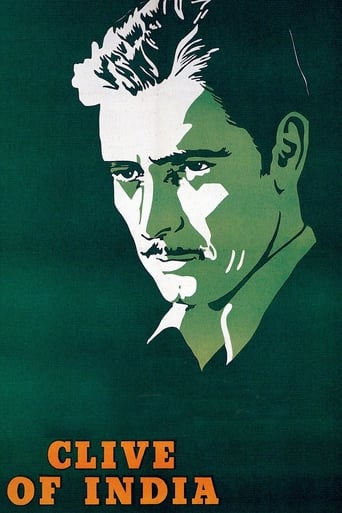

The acting in this movie is really good.
... View MoreAmazing worth wacthing. So good. Biased but well made with many good points.
... View MoreOne of the film's great tricks is that, for a time, you think it will go down a rabbit hole of unrealistic glorification.
... View MoreStrong acting helps the film overcome an uncertain premise and create characters that hold our attention absolutely.
... View MoreFunny in the last 20 min or so when Clive and his wife meet the General and an officer just back from India...to request Clive return for a 3rd time to fix things againNotice on the garden table his wife has left her laptop pc open during much of the scene. Hahaha....
... View MoreI love the period from the 1920s-1940s in film, however, there are a couple genres within this that I am less than fond of and try to avoid--such as musicals and costume dramas. Of course there are exceptions to the rule, but in general these are among my least favorite old films. With musicals, often the story seems unimportant and the songs dominate and with costumers, too often the tales look great and have nice sets and clothes but seem emotionally sterile."Clive of India", clearly, is a very sterile and dry film. Despite starring the wonderful Ronald Colman (one of my favorites), the picture comes off as episodic and amazingly dull. This is a shame, as the real life Sir Clive was an amazing man and as an American I am glad he fought in India and not North America--otherwise, we might still be a British colony! He was talented and yet also very screwed up (his suicide comes to mind) and how all this managed to be so dull is beyond me. I think it's because so much energy is spent on the sets and making it all look good that little attention was given to the script--the characters just seemed wooden and lifeless.Overall, you can watch it if you like, but I suggest you'd get more out of Wikipedia on this one!
... View More"Clive of India" does feature some rigorous battles with some raging elephants but only for a few frames and not nearly enough to satisfy any action fans. The director might even have culled some of the scenes from other films since the overall production values of this movie are not extravagant in any way. That said, Ronald Colman (as Clive) gives his usual excellent performance as the British officer who first brought India to its knees in the 18th Century. Loretta Young, looking as beautiful as a woman can be, co-stars as Clive's loving wife. Colin Clive, a distant relative of the real Clive of India, has a brief but important role as an arrogant aristocrat. Most film buffs will recognize the actor Clive as the gentleman who made such a great and lasting impression as Doctor Frankenstein in two of James Whale's early 1930's horror classics. The story here is perfunctory but Colman has a few good lines. After being brought before the House of Lords for disciplinary action, Clive is approached by one of his older peers who sneers at him, "If I were a younger man, I'd challenge you to a duel." Clive remains unperturbed and gives it back to the old fellow with interest."If you were a younger man, you wouldn't dare."
... View MoreJust how did India become part of the British Empire? This film will introduce you to Robert Clive, one of the great names in English history. After viewing, a perusal of the Encyclopaedia Britannica convinced me that essentially the film got most of the facts right. This is a colorful, sometimes a little violent, story (empires don't come easy) which also deals with the political complications for men who take Big Chances.Ronald Colman is always fun to watch. Loretta Young is beautiful, even if her American accent gets in the way of her performance occasionally. Cesar Romero, Colin Clive & Sir C. Aubrey Smith all have small rolls.The historical Clive died an opium addict and a suicide at the age of only 49. CLIVE OF INDIA shows us a little of his brilliance and tragedy.
... View More